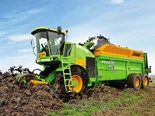New Zealand cows more efficient than 10 years ago
New Zealand's five million milking cows are doing a great job of efficiently producing milk, according to the latest 2014-15 dairy statistics.
New Zealand cows are producing more milk with more milksolids than 10 years ago.
A cow's annual average production contained 377 kilograms of milksolids (8.9%) in 2014-15, which is what New Zealand's dairy farmers are paid for, compared to 308 kilograms (8.6%) in 2004-05.
Cows from North Canterbury are the highest producers. On average each produced 4,706 litres of milk in 2014-15 with 416 kilograms of milksolids.
"North Canterbury cows recorded the highest milk volumes as well as the highest milkfat, protein and milksolids per cow. Taranaki cows recorded the highest percentage of milkfat and West Coast cows gave the highest percentage of protein and milksolids," says DairyNZ senior economist Matthew Newman.
The New Zealand dairy cow produced on average 4,235 litres of milk last season, 18 percent more than 10 years ago when she was producing 3,574 litres in 2004-05, according to the New Zealand Dairy Statistics 2014-15, published annually by industry body DairyNZ and herd improvement co-operative LIC.
In 2014-15 there were just over five million (5.02m) cows producing milk across the country, up from 4.9 million in 2013-14. However, this season farmers have been reducing cow numbers because of the low milk price, says Matthew.
In 2014-15 dairy companies processed 21.3 billion litres of milk containing 1.89 billion kilograms of milksolids. Total milksolids increased by 3.6 percent from the previous season.
"This was a record level of milk production and 56 percent higher on a milksolids basis than 10 years ago," says Matthew.
October is when the spring calving dairy cow hits her milking peak, producing a daily average of 1.98kg milksolids from 23.66 litres of milk in October 2014.
"It’s also when pasture is at its most plentiful and highest quality on farm, providing a perfect synergy which helps to make New Zealand's pasture-based farming system so efficient," says LIC’s genetics business manager Greg Hamill.
"That’s our core competitive advantage here in New Zealand – a cost-efficient pasture-based farming system, using great cows that are fed well – and that becomes even more important in seasons with a lower milk payout.
"Today’s New Zealand dairy cow, and the new benchmarks she sets each year, is a result of good breeding and high levels of genetic gain over many years. Combine that with the care and skill of the country’s 11,970 dairy farmers and their ongoing commitment to improving year on year, our cows are highly efficient converters of pasture into milk solids, and that is key to maximising a farm’s profitability."
Keep up to date with the latest farming news and events, subscribe to Farm Trader magazine here.
Keep up to date in the industry by signing up to Farm Trader's free newsletter or liking us on Facebook

.jpg)
.jpg)







